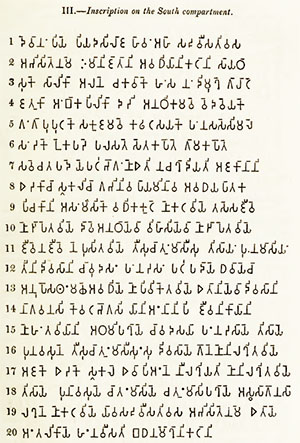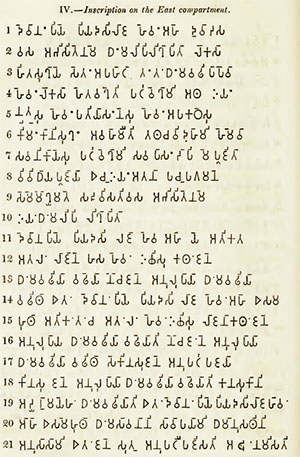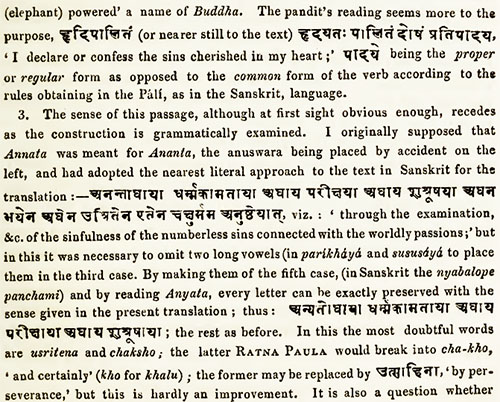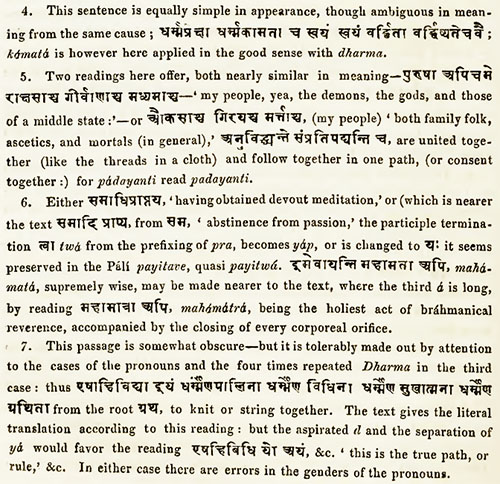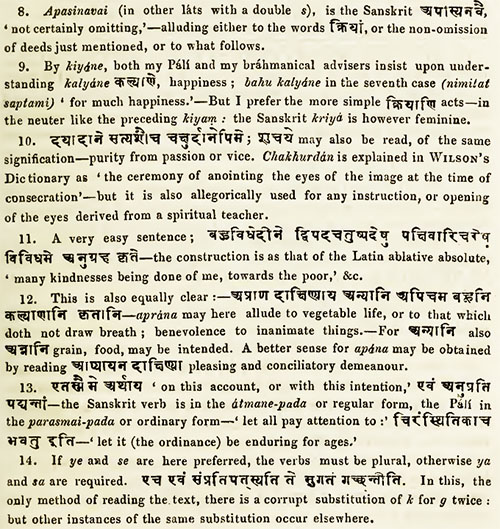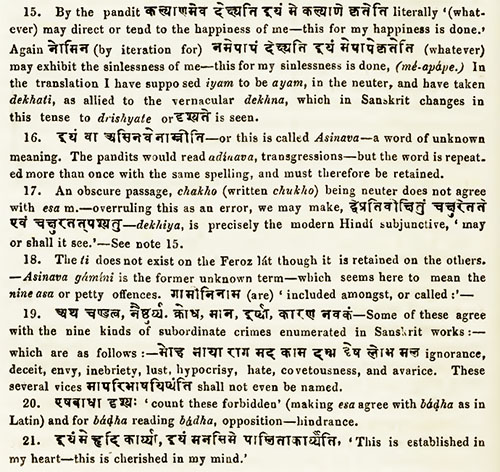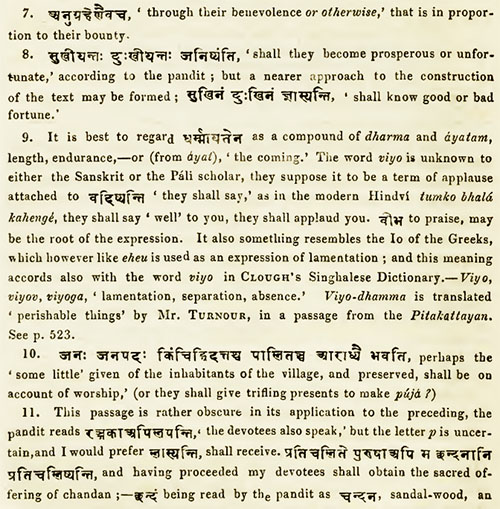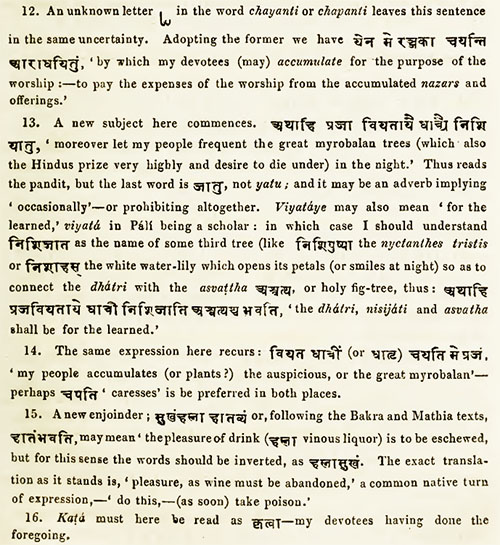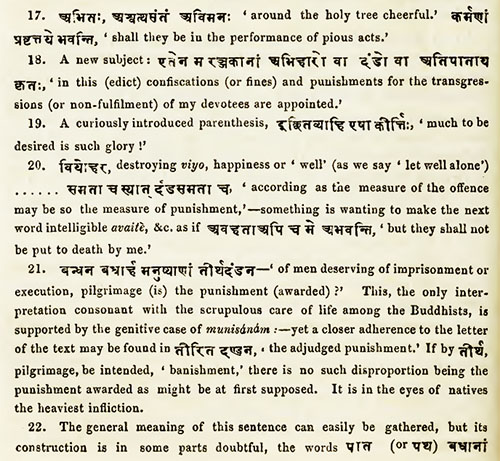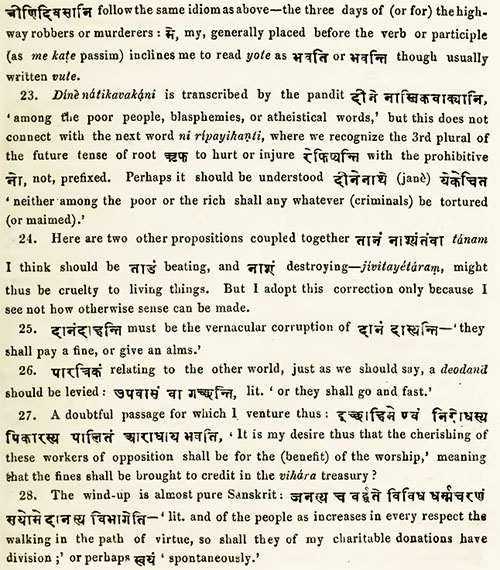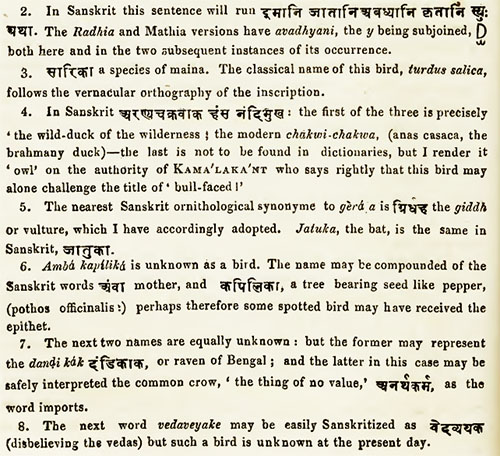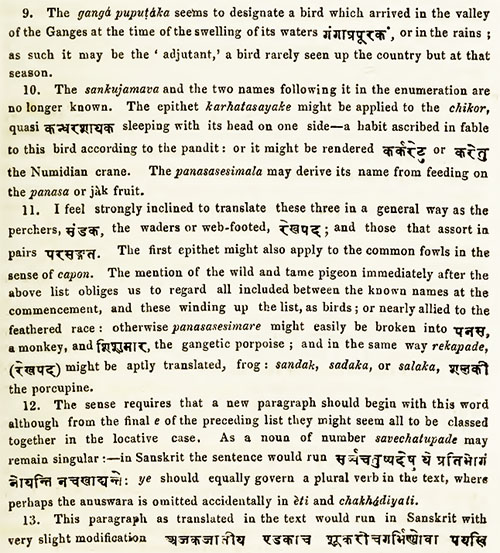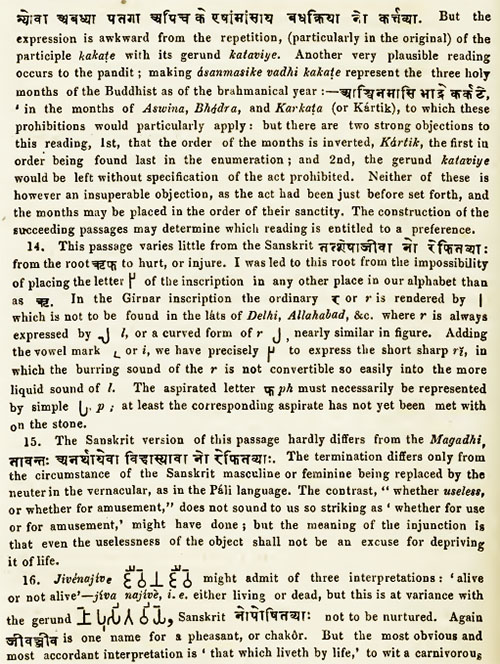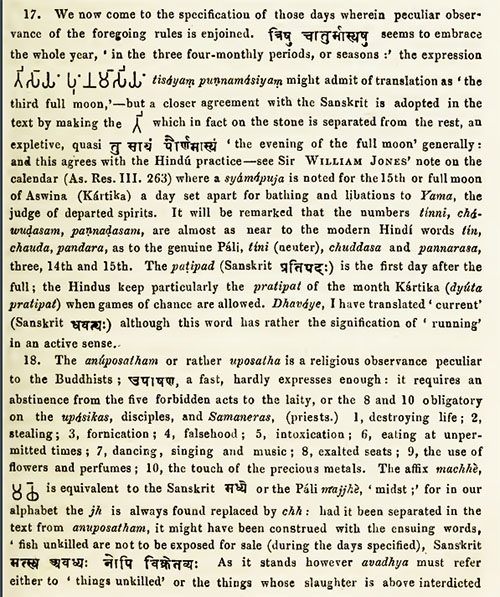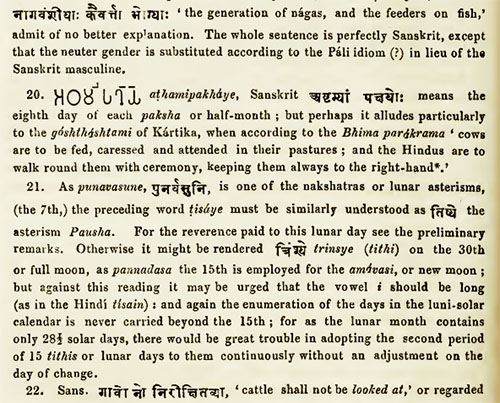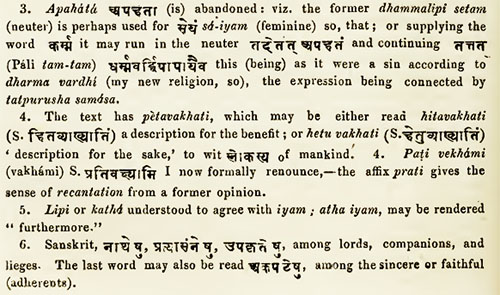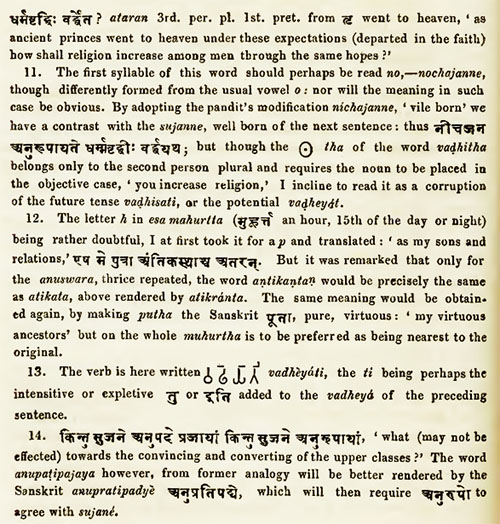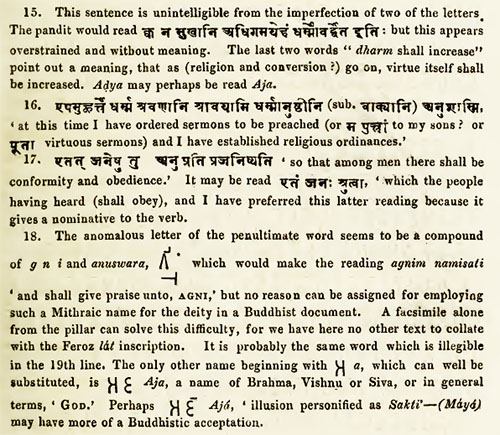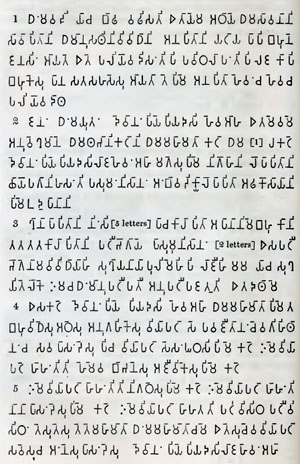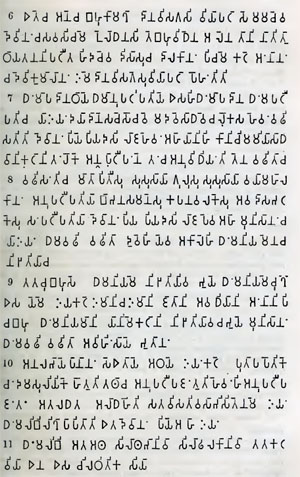An Analysis of the Dipawanso.
An examination of the Pali Buddhistical Annals, No. 4.
by the Honorable George Turnour, Esq., Ceylon Civil Service.
Journal of the Asiatic Society of Bengal, November, 1838 (p. 930).
No. 83.— November, 1838.
An Analysis of the Dipawanso.
The design of my last article was to prove, that the chronological authenticity of the Buddhistical records was intentionally deranged or destroyed at the period of Sakya's advent. In entering now upon the examination of that portion of the Pali annals, which professes to contain the genealogy of the royal dynasties of India, from the last regeneration of the world to the manifestation of Gotamo I have to adduce in my own case another instance, to be added to the many already on record, of the erroneous and exaggerated estimates, into which orientalists may be betrayed in their researches, when they rely on the information furnished by Indian pandits, without personally analyzing the authorities, from which that information is alleged to be obtained. I should, however, be doing the Buddhist priesthood of the present day in Ceylon very great injustice, if I did not at the same time avow, that the too favorable expectations in which I have indulged, as to the continuity, after having fully convinced myself of the chronological extravagancies, of the Pali genealogical annals anterior to the sixth century before the birth of Christ, have in no degree been produced by wilful misrepresentations on their part. It has been already noticed* [Introduction to the Mahawanso.] by me elsewhere, that the study of the Pali language is confined, among the natives of Ceylon, almost entirely to the most learned among the priesthood, and is prosecuted solely for the purpose of acquiring a higher order of qualification, for their sacerdotal functions, than those priests possess, who can consult only the vernacular versions of their scriptures. Their attention, therefore, is principally devoted to the examination of the doctrinal and religious questions contained in their sacred books; and that study is moreover conducted in a spirit of implicit faith and religious reverence, which effectually excludes searching scrutiny, and is almost equally unfavorable to impartial criticism. The tone of confidence with which my native coadjutors sought in the Pitakattayan for the several 'resolves' or 'predictions' of Buddho which are alluded to in a former paper*, [Journal for September, 1837.] and the frankness of the surprise they evinced, when they found that none of those 'resolves' were contained in the Pitakattayan, and only some of them in the Atthakatha, preclude the possibility of my entertaining any suspicion of wilful deception being practised. Confiding in their account of the historical merits of Buddhaghoso's commentaries, which appeared to me to be corroborated by the frequency of the reference made in the Tika of the Mahawanso to those Atthakatha, for details not afforded in the Tika, I had impressed myself with the persuasion, that the Atthakatha thus referred to were Buddhaghos's Pali commentaries. Great, as may be readily imagined, was our mutual disappointment, when after a diligent search, persevered in by the priests, with a zeal proportioned to the interest they took in the inquiry, we were compelled to admit the conviction that Buddhaghoso in translating the Sihala (Singhalese) Atthakatha into Pali, did not preserve the Indian genealogies in a connected and continuous form. He is found to have extracted only such detached parts of them, as were useful for the illustration of those passages of the Pitakattayan, on which, in the course of his compilation, he might be commenting. He himself says in his Atthakatha on the Dighanikayo, [Vide Journal of July, 1837.] "for the purpose of illustrating this commentary, availing myself of the Atthakatha, which was in the first instance authenticated by the five hundred Arahanta at the first convocation, as well as subsequently at the succeeding convocations, and which were thereafter brought (from Magadha) to Sihala by the sanctified Mahindo, and for the benefit of the inhabitants of Sihala were transposed into the Sihala language, from thence I translated the Sihala version into the delightful (classical) language, according to the rules of that (the Pali) language, which is free from all imperfections; omitting only the frequent repetition of the same explanations, but at the same time, without rejecting the tenets of the theros resident at the Mahawiharo (at Anuradhapura), who were like unto luminaries to the generation of theros and the most accomplished discriminators (of the true doctrines)." All, therefore, of these genealogies, excluded from his Atthakatha, which are now found only in the Tika of the Mahawanso, or in the Dipawanso, as well as much more perhaps, illustrative of the ancient history of India, which the compilers of these two Ceylonese historical works did not consider worth preserving, Buddhaghoso must have rejected from his commentaries, to which he gave almost exclusively the character of a religious work.
My Buddhist coadjutors are consequently now reluctantly brought to admit, that the Mahawanso, with its Tika, and Dipawanso are the only Pali records extant in Ceylon, which profess to contain the Indian genealogies from the creation to the advent of Sakya; and that even those records do not furnish the genealogies in a continuous form. And, now that my mind is divested of the bias which had been created by their previous representations, and which led me to attach great importance to the historical portions of Buddhaghoso's Atthakatha I cannot but take blame to myself for having even for a time allowed that impression to be made on me. The author of the Mahawanso*, [Pages xxxi. xxxii. xlii. xliii. of the Introduction to the Mahawanso.] in his Tika, declares more than once that he compiles his work from the Sihala Mahawanso and Atthakatha of the Mahawiharo, and from the Sihala Atthakatha of the Uttarawiharo fraternities, as well as from the Mahawanso of the Uttarawiharo priests. The last mentioned of these works alone, as far as I am able to form an opinion at present, was composed in the Pali language, at the time Mahanamo compiled his Mahawanso. I am induced to entertain this opinion from the circumstance, that Mahanamo's quotations from that work alone are in the metrical form, whereas all the translated quotations made by Pali authors from Sihala authorities are invariably, as might have been expected, rendered in prose. One of these quotations consists of the identical two verses with which the Dipawanso opens, and at the close of the Tika a reference is made to the Dipawanso for explanation of the violation of the Mahawiharo consecration, in the reign of Mahaseno. For these reasons, and as that work bears also the title of the "Mahawanso" or "the great genealogy," my Buddhist coadjutors concur with me in thinking, that the Dipawanso now extant is the Pali Mahawanso of the Uttarawiharo fraternity. In fact the titles of Dipa and Maha, are indiscriminately given to both these histories. To prevent, however, their being confounded with each other, I shall continue to reserve the title of Maha for Mahanamo's work, and that of Dipa for the prior compilation, the author of which has not yet been ascertained.
It has been shown in the introduction to the Mahawanso, that its author Mahanamo compiled his history in the reign of his nephew Dhatasino the monarch of Ceylon who reigned between A.D. 459 and 477, from the materials above described, a part of which was the version of the Atthakatha brought by Mahindo from India in 307 before Christ, and translated by him into the Sihala language. This fact, coupled with many other circumstances inadvertently disclosed in the histories of the convocations, go far to prove that the Pitakattayan and Atthakatha were actually reduced to writing from the commencement of the Buddhistical era, and that the concealment of their record till the reign of the Ceylonese ruler Wattagamini, between B.C. 104 and 76, was a part of the esoteric scheme of that creed, had recourse to in order to keep up the imposture as to the priesthood being endowed with the gift of inspiration. The cessation of the concealment of these scriptures at that particular period, though attributed to the subsidence of the spirit of inspiration, in all probability, proceeded from the public disorders* [Vide Mahawanso, Chap. 33.] consequent upon the Cholian invasion, which led to the expulsion of that king and the priesthood from Anuradhapura by a foreign enemy, and to their fugitive existence in the wilderness of the island during a period of nearly 15 years.
The Dipawanso from its being quoted by the author of the Mahawanso, is unquestionably a prior work; but as its narrative extends to the reign of Mahaseno in A.D. 302, its priority cannot exceed 150 years. In the Journal of December last, I have mentioned the circumstances under which I obtained possession of a Pali copy of the Dipawanso, in a very imperfect state, written in the Burmese character.
I proceed now to give my authority for pronouncing Piyadasi to be Dhanmasoko.
From a very early period, extending back certainly to 800 years, frequent religious missions have been mutually sent to each other's courts, by the monarchs of Ceylon and Siam, on which occasions an exchange of the Pali literature extant in either country appears to have taken place. In the several Solean and Pandian conquests of this island, the literary annals of Ceylon were extensively and intentionally destroyed. The savage Rajasingha in particular, who reigned between A.D. 1581 and 1592, and became a convert from the Buddhistical to the Brahmanical faith, industriously sought out every Buddhistical work he could find, and "delighted in burning them in heaps as high as a cocoanut tree." These losses were in great measure repaired by the embassy to Siam of Wilbagadere Mudiyanse, in the reign of Kirtisri Rajasingha in A.D. 1753, when he brought back Burmese versions of most of the Pali sacred books, a list of which is now lodged in the Dalada temple in Kandy.
The last mission of this character, undertaken however without any royal or official authority, was conducted by the chief priest of the Challia or cinnamon caste of the maritime provinces, then called Kapagama thero. He returned in 1812 with a valuable library, comprising also some historical and philological works. Some time after his return, under the instructions of the late Archdeacon of Ceylon, the Honorable Doctor Twisleton, and of the late Rev. G. Bisset, then senior colonial chaplain, Kapagama became a Convert to Christianity, and at his baptism assumed the name of George Nadoris de Silva, and he is now a modliar or chief of the cinnamon department at Colombo. He resigned his library to his senior pupil, who is the present chief priest of the Challias, and these books are chiefly kept at the wihare at Dadala near Galle. This conversion appears to have produced no estrangement or diminution of regard between the parties. It is from George Nadoris, modliar, that I received the Burmese version of the Tika of the Mahawanso, which enabled me to rectify extensive imperfections in the copy previously obtained from the ancient temple at Mulgirigalla, near Tangalle.
Some time ago the modliar suggested to me that I was wrong in supposing the Mahawanso and the Dipawanso to be the same work, as he thought he had brought the Dipawanso himself from Burmah. I was sceptical. In my last visit, however, to Colombo, he produced the book, with an air of triumph. His triumph could not exceed my delight when I found the work commenced with these lines quoted by the author of the Mahawanso* [Vide in the quarto edition the introduction to the Mahawanso, page xxxi.] as taken from the Mahawanso (another name for Dipawanso) compiled by the priests of the Utaru wihare at Anuradhapura, the ancient capital of Ceylon. "I will perspicuously set forth the visits of Buddho to Ceylon; the histories of the convocations and of the schisms of the theros; the introduction of the religion (of Buddho) into the island; and the settlement and pedigree of the sovereign Wijayo."...
In one of the narratives of this book, containing the history of Dhanmasoko, of Asandhimitta his first consort after his accession to the Indian empire, of his nephew Nigrodho, by whom he was converted to Buddhism, and of his contemporary and ally Dewananpiyatisso, the sovereign of Ceylon, — Dhanmasoko is more than once called Piyadaso, viz.:"Madhudayako pana wanijo Dewalokato chawitwa, Pupphapure rajakule uppajitwa Piyadaso kumaro hutwa chhattan ussapetwa sakala-jambadipa eka-rajjan akasi*." [Vide page 24 of the Mahawanso for an explanation of this passage.]
"The honey-dealer who was the donor thereof (to the Pache Buddho) descending by his demise from the Dewaloko heavens; being born in the royal dynasty at Pupphapura (or Patilipura, Patna); becoming the prince Piyadaso and raising the chhatta, [Parasol of dominion.] established his undivided sovereignty over the whole of Jambudipo'' — and again —
"Anagate Piyadaso, nama kumaro chhattan ussapetwa Asoka nama Dhanma Raja bhawissati."
"Hereafter the prince Piyadaso having raised the chhatta, will assume the title of Asoka the Dhanma Raja, or righteous monarch."
It would be unreasonable to multiply quotations which I could readily do, for pronouncing that Piyadaso, Piyadasino [Piyadassino is the genitive case of Piyadasi, [x]: — Ed.] or Piyadasi, according as metrical exigencies required the appellation to be written, was the name of Dhanmasoko before he usurped the Indian empire; and it is of this monarch that the amplest details are found in Pali annals. The 5th, 11th, 12th, 13th, 14th, 15th, 16th, 17th, 18th, 19th, and 20th chapters of the Mahawanso contain exclusively the history of this celebrated ruler, and there are occasional notices of him in the Tika of that work, which also I have touched upon in my introduction to that publication. He occupies also a conspicuous place in my article No. 2, on Buddhistical annals. His history may be thus summed up.
-- Further notes on the inscriptions on the columns at Delhi, Allahabad, Betiah, &c., by the Hon'ble George Turnour, Esq. of the Ceylon Civil Service, The Journal of the Asiatic Society of Bengal, Vol. VI, Part II, Jul-Dec, 1837
As this work and the Mahawanso, with its Tika, are the best Pali records I possess of the Indian genealogies, I shall proceed to make extracts from such parts of the Dipawanso as may throw light on this subject; adding a note in those cases, in which the Tika is either fuller than, or at variance from, the Dipawanso. I shall not attempt to tabularize these dynasties, as the lists of kings is avowedly and manifestly incomplete, and as no continuous chronological results could be safely deduced from any table formed from such mystified data. It will be observed that the names of even the three rajas, during whose reigns the three Buddha who preceded Gotamo were manifested in this kappo, are omitted in these lists. And yet there are detached notices of those kings, as well as of other Indian rajas, both in the text and commentaries of the Buddhistical scriptures, which are in themselves well worthy of consideration, and to which I shall advert in future contributions.
The author of the Dipawanso has certainly spared no pains in his endeavours to make the links of the Theraparampara chain complete, and consistent with chronology. He, however, only gives the succession of preceptors, who were the guardians of the Wineyo section of the Pitakattayan, commencing with Upali, whose death is placed in the sixth year of the reign of Udayo; while the incongruities I have dwelt upon in the paper No. 2, have reference to Sabhakami, who though a cotemporary disciple of Buddho, has been represented to have presided at the second convocation, a century after Sakya's death; when he must, from the date of his upasampada ordination, have been at least 140 years old. But even this succession of the Wineyan line of preceptors, the chronological particulars of which are pretended to be given with so much precision in the following extracts, will not stand the test of scrutiny by a person conversant with the rules that govern the Buddhistical church. It is an inviolable law of that code, established by Buddho himself at an early period of his mission, and adhered to to this day — to which rule there are only two well known exceptions — that no person, whether a noviciate priest called Samanero, or an ascetic layman, however learned or pious he may be, can be ordained an upasampada before he has completed his twentieth year. The two exceptions alluded to are the instances of Sumano and Sopako who were ordained upasampada at seven years of age.
It will be seen that this line of preceptors, extending from the date of Buddho's death to the third convocation, a term of 236 years, is made to consist of five successions. Upali the cotemporary of Buddho, is stated to have been 60 years old in the eighth year of the reign of Ajatasattu, which is the 16th year A.B. He is represented to have survived Buddho thirty years, and to have died in the 6th of Udayo's reign in A.B. 30. It is not however, mentioned how many years he had been an upasampada, and all these dates work out therefore without disclosing any discrepancy.
Dasako is represented to be his pupil and immediate successor, and he is stated to be 45 years old in the 10th of Nagasoko's reign, which falls to A.B. 58. He was born, therefore, A.B. 13, and his preceptor Upali died A.B. 30. Supposing his ordination had been put off to the last year of Upali's life, he could not have been more than 17, when made an upasampada. So far from being qualified to be the custos of the Wineyo, he wanted three years of the age to make him admissable for ordination. But we are further told, that he died at the age of 64 in the eighth of Susunago's reign, which falls to A.B. 80: having then been an upasampada 50 years, he must necessarily have been ordained at 14 years of age. But there is manifestly some trifling error somewhere; for, by the latter dates he must have been born not A.B. 13, but A.B. 16.
Sonako was Dasako's successor: he was 40 in the 10th year of Kalasoko's reign, which was A.B. 100; he was born therefore in 60, and he is stated to have died at the age of 66 in the sixth of the reign of the Nandos, which falls to A.B. 124. He was therefore only 20 years old when his preceptor died: but it is specifically stated that he had been a learned upasampada 44 years when he died; and consequently Sonako also could only have been 16 years when ordained.
Siggawo and Chandawo or Chandawajji were the co-disciples and successors of Sonako. Siggawo was 64 years old in the second of Chandagutto's* [I assign in these remarks 24 years to the reign of Chandagutto, which will bring Asoko's accession to A.B. 214, and his inauguration, four years afterwards, to A.B. 218.] reign A.B. 164, and he died aged 76 in the 14th of that reign A.B. 176. He was born therefore A.B. 100, and yet we are told, that it was in this very year, the 10th of the reign of Kalasoko, they were ordained upasampada, by Sonako. There is a manifest error, therefore, in the term of five years assigned for Siggawo's upasampadaship. As his ordaining preceptor Sonako died A.B. 124, he must have been at that time only 24 years old, and at his own death an upasampada of 76 years' standing, — a term co-equal with his natural life. In various parts of the Atthakatha, and in the fifth chapter of the Mahawanso likewise it is stated that they were "adult priests" at the time the second convocation was held; and indeed it is specifically stated in page 30, that Siggawo was 18 years old when he was first presented to Sonako. The pretended prophecy, delivered to him and Chandawajji at the close of that convocation, would consequently be nullified at once, if their birth be not dated anterior to A.B. 100: manifestly, therefore, these dates also are an imposition.
Lastly, Moggaliputtatisso was their disciple; he was ordained in the second of Chandagutto A.B. 164, and he was 66 in the sixth of Dhammasoko A.B. 220; he was born, therefore, in A.B. 154, and could only have been 14 years old at the death of Siggawo, when he became the chief of the Wineyo preceptors. He is stated to have died in the 26th of Dhammasoko, A.B. 240, aged 80. This gives A.B. 160 instead of A.B. 154 for his birth, being a discrepancy of six years.
On pointing out to my pandits, that, even in this elaborate adjustment of the succession of preceptors, the number of lives given is found to be insufficient to fill up a term of 236 years, without bringing the several preceptors into office before they had attained the prescribed age, they at once decided, that the author of the Dipawanso has put forth an erroneous statement, and that the whole ought to be rejected as unfounded. How the discrepancies are to be rectified they do not suggest, beyond hazarding a conjecture, that each preceptor, like Sabhakami, must have lived to a more advanced age; and that each succeeding preceptor consequently had attained a maturer standing at the period of his succession.
It is time, however, that I should proceed to extracts from the Dipawanso.
The Third Bhanawaro of the Dipawanso.
"Omitting the rajas who existed in former kappa, I will in the fullest manner narrate (the history of) the rajas of the present creation. I shall perspicuously set forth the regions in which they existed, their name and lineage, the term of their existence, and the manner in which they governed: whatever that narrative may be, attend ye thereto.
"The first individual who was inaugurated a raja, the protector of the land, was named Mahasammato; he was superlatively endowed with personal beauty; that Khattiyo exercised the functions of sovereignty.
"Rojo was his son, Wararojo, the monarch Kalyano; Warakalyano, Uposatho, Mandato* [In the Mahawanso, I have been misled by the plural Mandata, and reckoned two kings of that name. I see by the Tika the name should be in the singular Mandato. The twenty-eight rajas who lived for an Asankheyyan include therefore Mahasammato.] the seventh in succession, a supreme ruler of the four dipa [Jambudipo, Uttarukuru, Aparagoyanan and Pubbawideho.], endowed with great wealth; Charo, the raja Upacharo, and Che'iyo abounding in riches; Muchalo; Mahamuchalo, Muchalindo, Sagaro; Sagaradewo, Bharato, Bhagiratho the Khattiyo; Ruchi, Maharuchi, Patapo, Mahapatapo, Panado, Mahapanado, the Khattiyo Sudassano, Mahasudassano, and in like manner two of the name of Neru; and Achchima [This name also has been erroneously omitted by me in the Mahawanso. Achchima was there read Pachchima. The Tika, however, shows that the Dipawanso is correct.], (were successively the sons of each preceding ruler.) The term of existence of these twenty-eight rajas was an Asankheyyan; and the capitals in which these monarchs, whose existence extended to an Asankheyyan, reigned, were Kusawati, Rajagahan and Methila."
(Here follows the rule by which an Asankheyyan is to be computed.)
"The descendants of Achchima were one hundred; and they ruled supreme in their capital called Sakula. [In the Tika, it is further stated: "The eldest son of Achchima was the monarch Wattaparasani, though his name be not preserved, quitting Mithela in the same manner that the Okkbka family quitting Baranasi founded Kapilawathu in a subsequent age, established himself at Kasawati, raised the Chhata there, and there his dynasty flourished. His lineal successors in that empire were in number ninety- nine, the last of whom was Arindam, and they all ruled there under the designation of the Achchima dynasty." I should infer from this passage that the capital called Sakula in the Dipawanso should be Kusawati.] The last of these was the Khattiyo Arindamo; his descendants, fifty-six monarchs in number, reigned supreme in their capital Ayujjhapura.
"The last of these was Duppasaho, a wealthy monarch; his descendants were sixty rulers, who reigned supreme in their capital Baranasi.
"The last of these was Ajitajano; his descendants eighty-four thousand in number ruled supreme in their capital Kapilanagaran.
"The last of these was Brahmadatto, greatly endowed with riches; his descendants were thirty-six rajas in number, who reigned supreme in their capital Hatthipura.
"The last of these was the raja Kambalawasabho; his descendants were thirty-two monarchs, who reigned supreme in their capital Ekachakkhu.
"The last of these was the illustrious Purindadewo; his descendants were twenty-eight monarchs, who reigned supreme in their capital Wajirapura.
"The last of these was the raja Sodhano; his descendants were twenty monarchs and they reigned supreme in their capital Madhura.
"The last of these was the raja Dhammagutto, powerful in his armies; his descendants were eighteen monarchs, who reigned supreme in their capital Aritthapura.
"The last of these was the raja Narindasitthi*; [In the Tika there are the following variations of appellation from the Dipawanso:] 1 [Brahmasiwo.] his descendants were seventeen kings, who reigned supreme in their capital Indapattapura.
"The last of these was Brahmedewo2 [Brahmadatto.] raja; his descendants were sixteen monarchs, who reigned in their capital Ekachakkhu.
"The last of these was the monarch Baladatto3; [Baladewo.] his descendants were fourteen rulers, who reigned supreme in their capital Kasambinagaran.
"The last of these was celebrated under the title of Bhaddadewo4; [Hatthidewo.] his descendants were nine kings, who reigned in their capital Kannakochchhanagaran.
"The last of these was the celebrated Naradewo; his descendants were seven monarchs, who reigned supreme in their capital Rajananagaran.
"The last of these was the raja Mahindo; his descendants were twelve kings, who reigned supreme in their capital Champakanagaran.
"The last of these was the monarch Nagadewo; his descendants were twenty-five rulers, who reigned supreme in their celebrated capital Mithila.
"The last of these was Buddhadatto5, [Samuddhadatto.] a raja powerful by his armies, his descendants were twenty-five monarchs, who reigned supreme in their capital Rajagahan.
"The last of these was Dipankaro; his descendants were twelve rajas, who reigned supreme in their capital Takkasila.
"The last of these was the raja Talisakaro, his descendants were twelve rulers, who reigned supreme in their capital Kusinara.
"The last of these was the raja Purindo; his descendants were nine kings, who reigned supreme in Tamaliti.
"The last of these was the worthy monarch Sagaradewo, whose son Makhadewo [The Tika observes in reference to the Mahawanso, that according to the Atthakatha Makhadewo is reckoned among the eighty-five thousand successors of Sagaradewo, whereas that number should be exclusive of him.] was pre-eminent for his deeds of charity; his descendants were eighty-four thousand monarchs, who reigned supreme at Mithila.
"The last of these was Nemi, a monarch who received offerings from the Dewa and was a Chakkawatti (powerful sovereign), whose dominions were bounded by the ocean: the son of Nemi was Kalakajanako*; [Here also the Tika notices in reference to the Mahawanso that the eighty- five thousand are to be reckoned exclusive of Samankuro and Asoko.] his son was Samankuro: and his son was Asoko; and his descendants were eighty-four thousand rulers who reigned supreme in their capital Baranasi.
"The last of these was the raja Wijayo, a wealthy monarch: his son was Wijitaseno who was endowed with great personal splendor. Dhammaseno, Nagaseno, Samatho, Disampati, Rainu, Kuso; Mahakuso, Nawaratho, Dasaratho, Ramo, Bilaratho, Chittadassi, Atthadassi, Sujaro, Okkako [Vide Mahawanso Introduction, p. xxxv. for the establishment of the Sakyan dynasty of Okkakamukho.], Okkakamukho, Nipuro, Chandima, Chandamukho, Siriraja, Sanjayo, the monarch Wessantaro, Jalo, Sihawahano and Sihassaro. These were enterprising monarchs, who upheld the pre-eminence of their dynasty; and his (Sihassaro's) descendants were eighty-two thousand, who (all) reigned supreme in their capital Kapilawatthu.
"The last of these was Jayaseno; his son was Sehahanu who was endowed with great personal splendor. Unto the said Sehahanu there were five sons. Those five brothers were Suddhodano, Dhotodano, Sukkodano, Ghatitodano and Amitodano. All these rajas were distinguished as Odano [This word literally signifies "boiled rice:" no reason is assigned for adopting the designation.]. Siddattho, the saviour of the world, was the son of Suddhodano; and after the birth of his illustrious son Rahulo, finally relinquished (worldly grandeur) for the purpose of attaining Buddhohood.
"The whole of these monarchs, who were of great wealth and power, were in number one lakh, four nahutani§ [In this sense a nahutan is 10,000, making therefore 140,300 monarchs. According to the Tika there were 252,539 rajas from Mahasammato to Okkako, the Ikswaku of the Hindus.] and three hundred. Such is the number of monarchs of the dynasty from which the Bodhisatto (Buddho elect) is sprung.
"Perishable|| [This is a passage of the Pitakattayin as propounded by Sakya.] things are most assuredly transitory, it being their predestiny that after being produced they should perish; they, accordingly, being produced, pass away. To arrest this (eternity of regeneration and destruction, by the attainment of nibbanan) is indeed to be blessed."
The conclusion of the Maharajawanso.
"The raja Suddhodano, the son of Sehahanu was a monarch who reigned in the city called Kapila; and the raja Bhatiyo was then the monarch who reigned at Rajagahan, a city situated in the centre of five [The names of these mountains are Isigiii, Wibharo, in which is situated the Sattapanni cave in which the first convocation was held; Weputto; Pandawo aud Gejjhakato, the mountain where Buddho dwelt last in the neighbourhood of Rajagakan.] mountains. These two rulers of men, Suddhodano and Bhatiyo, the descendants (of royal dynasties) from the commencement of the kappo, were intimately attached to each other.
"By (Bimbisaro the son of Bhatiyo) these five wishes were conceived in the eighth year of his age. 'Should my royal parent invest me with sovereignty: should a supreme of men (Buddho) be born in my dominions: should a Tathagato select me for the first person to whom he presented himself: should he administer to me the heavenly dhammo; and should I comprehend that supreme dhammo — these will be blessings vouchsafed to me.' Such were the five wishes conceived by Bimbisaro.
"Accordingly, on the demise of his father, he was inaugurated in the fifteenth year of his age: within his dominions the supreme of the world was born: Tathagato repaired to him as the first person to whom he presented himself: propounded the heavenly dhammo: and the monarch comprehended it.
"Mahawero was not less than thirty-five years old, and the monarch Bimbisaro, was in the thirtieth year of his age. Gotamo therefore was five years senior to Bimbisaro. That monarch reigned fifty-two years, thirty-seven of which he passed contemporaneously with Buddho.
"Ajatasattu (his son) reigned thirty-two years: in the eighth year of his inauguration, the supreme Buddho attained nibbanan. From the time that the omniscient Buddho, the most revered of the world and the supreme of men attained Buddhohood, this monarch reigned twenty-four years."


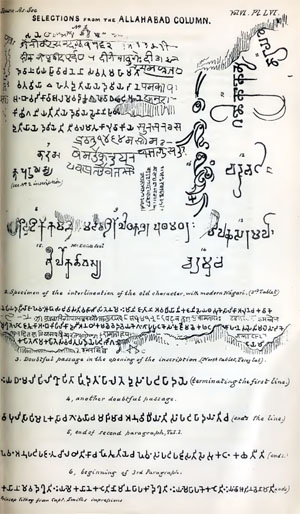
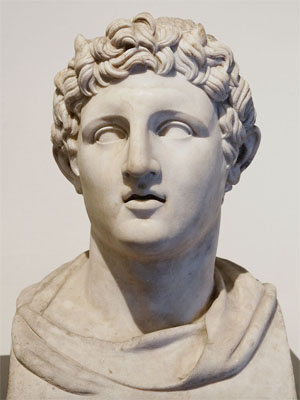
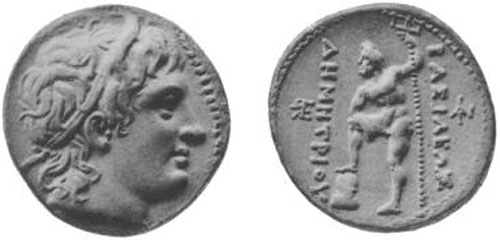
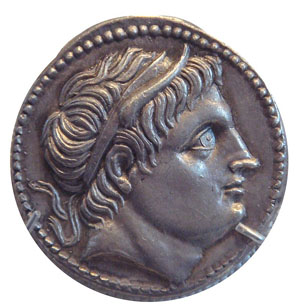
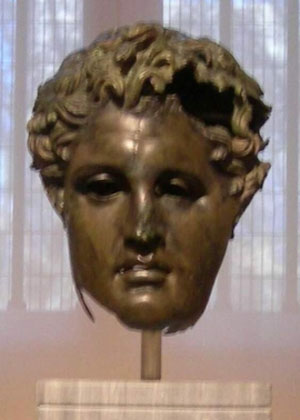
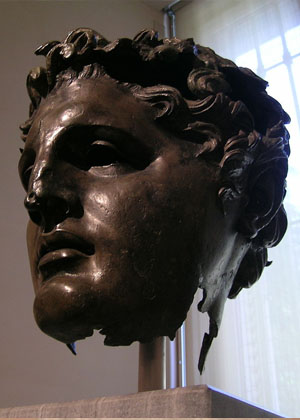
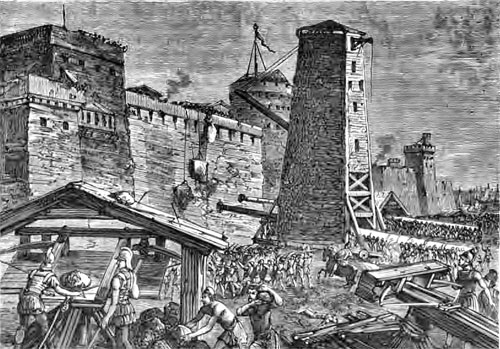
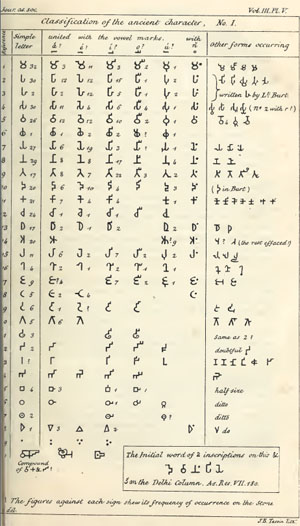

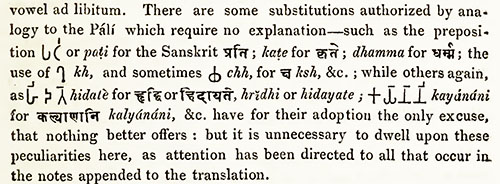
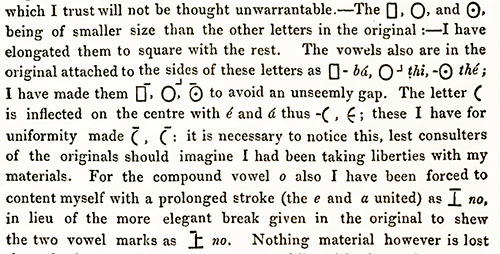
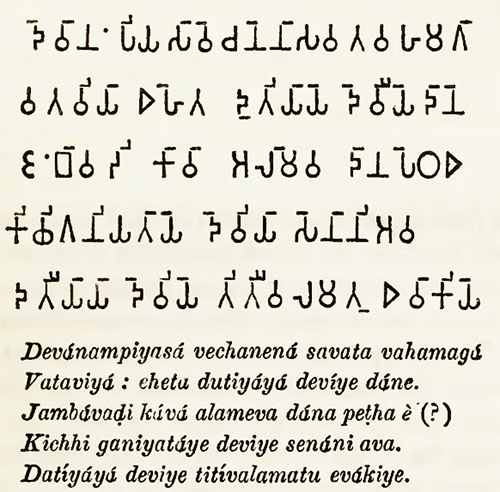



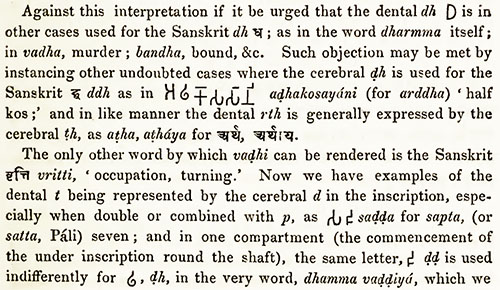






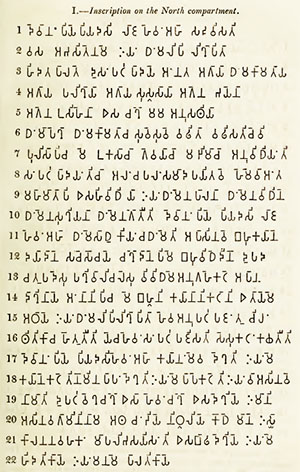
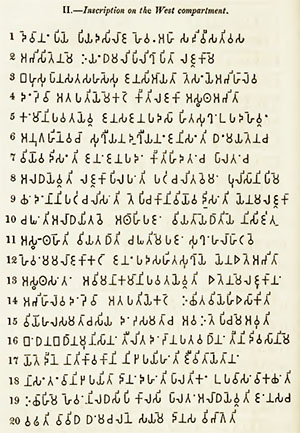
 the rest as here given.]
the rest as here given.] 